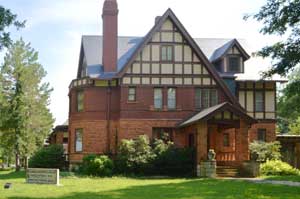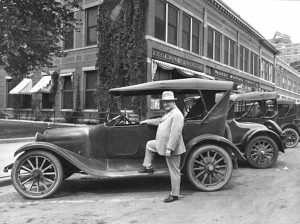William Allen White was a journalist, author, and one of the best-known men in Kansas during his lifetime.
White was born in Emporia, Kansas, on February 10, 1868, to Dr. Allen and Mary Hatton White. In 1869, Dr. White moved to El Dorado, Kansas, where William was raised. After graduating from high school, he worked for the Butler County Democrat, and in 188,6 he began his real newspaper career as a reporter and city circulator for the El Dorado Republican. Next, he learned to set type, run a job press, and write items for a country newspaper. In the fall, he went to Lawrence to attend the state university but returned to work on the paper at the close of the school year. During 1887 and 1888, he again attended the university and, in the summer of 1888, worked on the Lawrence Journal as a reporter.
In 1890, he left college without completing his courses and returned to work on the El Dorado Republican. From El Dorado, he went to Kansas City, Missouri, as a correspondent and editorial writer on the Kansas City Journal and, subsequently, on its rival, the Kansas City Star. In 1895, he borrowed money and bought the Emporia Gazette to have a paper he could run to suit himself. The paper was on the downgrade when he purchased it, but within three years, he had paid for it and expended $1,000 on improvements. White ran the Gazette as an independent Republican journal and became unrivaled in the city for newspaper publishing.
In 1893, he married Sallie Lindsay of Kansas City, Kansas; the couple had one child. During the 1896 campaign, he wrote an article titled “What’s the Matter with Kansas,” which the national press quickly picked up. The Chairman of the Republican National Committee, Mark Hanna, made the statement that this editorial “was more widely circulated by the Republican National Committee than any other document sent out by it.” White was regarded as an asset by both the Republicans and Democrats. He was described as having a mixture of simplicity and shrewdness, yet no one could guess what he would do or say next, while behind his eccentricities lay a real, honest, warm-hearted man.
One of his first books was a collection of stories entitled The Real Issue, which was a success. His articles on public men, published in McClure’s Magazine, stirred political circles. In 1899, he published a study of boy life under the title Court of Boyville, and later published In Our Town and A Certain Rich Man, which brought him much acclaim. In 1923, he won a Pulitzer Prize for his editorial To an Anxious Friend, published on July 27, 1922, after being arrested in a dispute over free speech following objections to the way the State of Kansas handled the men who participated in the Great Railroad Strike of 1922.

William Allen White’s house in Emporia, Kansas, is a state historic site (photo by Kathy Alexander).
Objecting to the rise of the Ku Klux Klan in the state, he ran unsuccessfully for Kansas Governor in 1924. White continued to write countless editorials, articles, and books that earned him the title of the “Sage of Emporia.” He died on January 29, 1944. His posthumously published autobiography won a 1946 Pulitzer Prize. The Emporia Gazette is still run by his descendants today.
©Kathy Alexander-Alexander/Legends of Kansas, updated December 2025.
Check out this documentary on YouTube – William Allen White: What’s the Matter with Kansas (Director’s Cut), from the William Allen White Foundation.
Also See:
See Sources.

